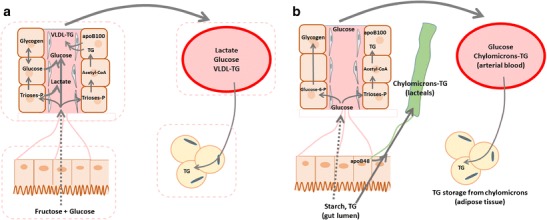Fig. 2.

Pathways used for lipid storage from dietary fructose and dietary fat. Fructose (a) is essentially extracted and metabolized in the liver, where part of it can be converted into lactate, glucose, fatty acids, and triglycerides. Newly synthesized glycogen can be temporarily stored as hepatic glycogen, but its major portion is slowly released into the systemic circulation as glucose. Hepatic fructose handling differs from glucose (whether ingested as free glucose, sucrose, or starch; b), which is only partially extracted by the liver to replenish glycogen stores. Its largest portion however reaches the systemic circulation, elicits an increase in blood glucose and insulin concentration, and is metabolized in insulin-sensitive tissues (muscle, adipose tissue) within a few hours. After fructose ingestion, new fat synthesized de novo in the liver can be temporarily stored within the hepatocytes and/or be secreted with VLDL to be secondarily deposited in adipose tissue (a). In contrast, ingested fat is mainly absorbed as chylomicrons which circulates in the lymph, thus bypassing the liver; chylomicrons-TG will then join the systemic circulation and be deposited in adipose tissue (b)
